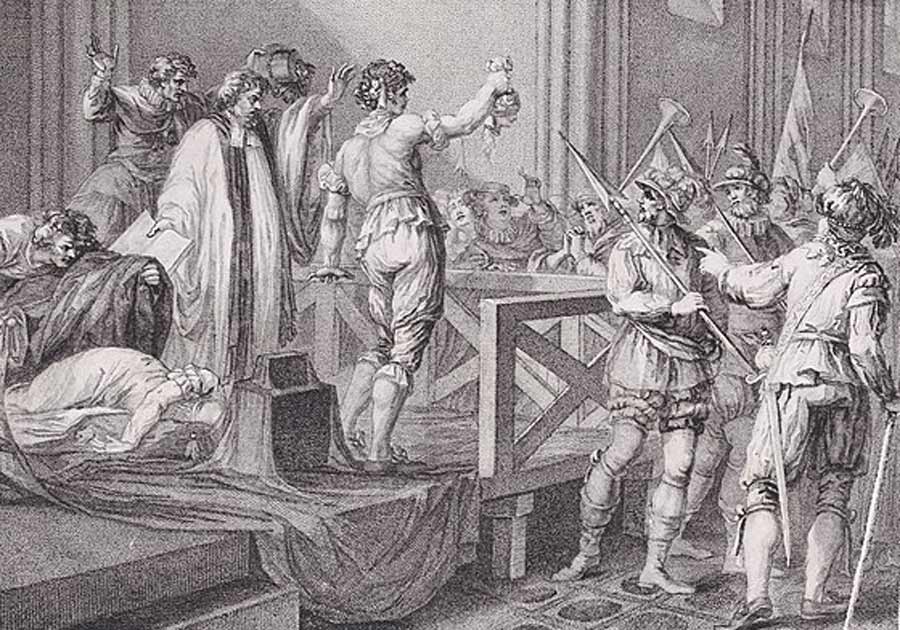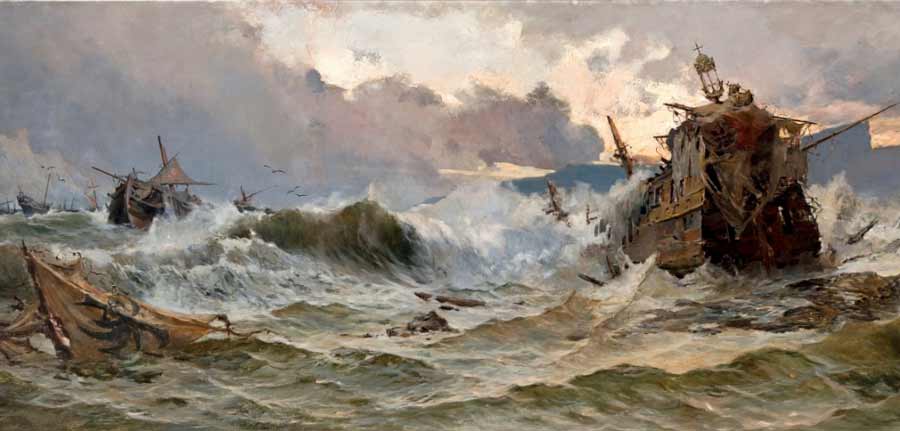England has, as an island, always been easy to defend. Julius Caesar struggled to cross the channel in 55 and 54 BC, and millennia later Hitler was forced to put his invasions plans, codenamed Operation Sealion, on hold too.
But there have, over the centuries, been concerted attempts to overcome the natural barrier of the sea and successfully invade England. And few attempts were as determined, and few came so close to succeeding, as the Spanish Armada of 1588.
A Tense Time for England and Spain
The seeds of distrust between the countries had been long in the making and England’s monarch, Elizabeth I, was in a complex position, although not a position of her own making. The root of the problem came in the actions of her father, Henry VIII.
The English Reformation and move away from Catholic Europe began with King Henry VIII’s wish to divorce his first wife, Catherine of Aragon, primarily as a political exercise to free him to marry again. However this shift in religion in England took root and, during the reign of Henry’s son Edward VI, England became increasingly connected with the Protestant reformation taking place in Europe.
Edward died young and left no heir, and in 1553 his half-sister Mary took the kingdom. Mary and her husband, Philip II of Spain, reasserted Roman Catholic control over the English Church. More than 260 people were burnt at the stake as a result of her efforts, garnering her the moniker Bloody Mary.
Mary would only rule for five years, and following the death in 1558 her half-sister Elizabeth ascended to the throne. Unlike Mary, Elizabeth was apparently a genuine believer in reform and promptly carried out many of Edward’s measures.
Spain by this point had several grievances. Henry VIII’s first wife, whom he had divorced, was Spanish and the divorce was never accepted by Spain. The break with Catholicism gave them religious cause to feel wronged, and furthermore Philip, the Spanish king, had been supplanted on the English throne by a Protestant woman.

Furthermore, the Catholic heir to the English throne, Mary Queen of Scots, was finally executed by Queen Elizabeth in 1587 due to the constant coup attempts being made in her name. She was simply too visible a figurehead and rallying point for anti-Elizabeth sentiment to be allowed to live.
On top of all this, English (and Dutch) ships had been raiding Spanish galleons and stripping them of treasure being taken back from the New World. Spain’s economy at this time was almost in deadlock due to its dependence on wealth from its colonies and disrupting that flow of income risked creating serious political instability. And the English and Dutch combination was an alliance directly against Spain.
A Conquering Armada
Incensed by the death of Mary Queen of Scots and determined to depose the Protestant Queen of England, a Habsburg Spanish fleet of 130 ships set sail from Spain in late May 1588. The fleet was under the leadership of the Duke of Medina Sidonia, an aristocrat and confidante of Philip II, with the mission of guiding an army from Flanders to invade England.
The goal was to depose Queen Elizabeth I and her Protestant reforms in England, as well as to cease English intervention in the Spanish Netherlands and the damage caused by English and Dutch privateering ships disrupting Spanish interests in the Americas. The ships which made up the core of the Armada were huge, with special metal reinforcement of the hull and masts designed to make them unsinkable.
From Plymouth, English ships set sail to confront the Armada. As the Armada proceeded east along the south coast of England, the sheer size of the Spanish galleons made them slow, easy targets, allowing the English to fire on the Armada without losing any ships.
Unexpectedly driven off by the English, the Spanish Armada could have still safely anchored in The Solent between the Isle of Wight and the English mainland. Occupying the Isle of Wight would have put them right at England’s doorstep, with their ships sheltered from damage.

But Medina Sidonia was under orders from King Philip II to meet up with Alexander Farnese, Duke of Parma’s forces in the Netherlands so that Parma’s soldiers and other soldiers carried in Armada ships could invade England. The Armada pressed on eastwards, taking damage from English guns all the while. Francis Drake, England’s charismatic and talismanic captain, even succeeded in taking a Spanish ship.
Taking The Initiative
But what the Spanish didn’t know was that the English were running very low on ammunition for the cannon on their warships. In any sustained engagement the Spanish would be highly favored to win as the English would simply not be able to fire.
Furthermore, if the Spanish managed to land troops in England and march on London it was unclear whether they could be resisted. With Spanish dominance of the Channel and Parma’s soldiers transported safely a Spanish victory looked possible.
The English needed to act, and act quickly. Rather than wait for the Spanish to come to them, a desperate plan was hatched to attack the Spanish an anchor, where they thought they were safe. An all-out assault could not hope to work either as the Spanish were too well defended: something else was needed.
After the skirmishes with the English has broken up the Spanish fleet formation, Medina Sidonia attempted to reassemble his fleet at Gravelines, part of Flanders in the Spanish Netherlands. Close to the French border, it was the closest Spanish territory to England.
Medina was hesitant to go farther east as the shoals in the area were known to be dangerous and he did not want to risk losing any ships. Furthermore, his Dutch adversaries had destroyed the sea markings in the area, making safe navigation all but impossible.
So the English had a pretty good idea where the fleet would be. Furthermore, the English had learned much from their initial conflicts in the Channel. The Spanish ships were slow and not maneuverable, presenting easy targets. The English had also found it was possible to penetrate even the reinforced Spanish hulls at point blank range, say 100 yards (91 m).
The Spanish ship captured by Drake, the Nuestra Seora del Rosario also gave up her secrets. It was discovered that the Spanish ships were very cramped inside, with large amounts of onboard supplies carried on the cannon decks. Cannons could not be reloaded easily and it was found that, in a combat scenario, the Spanish only intended to fire once and then proceed to attempt to board the enemy.
Armed with this knowledge, what could the English do to break apart this armada?
Fireships in the Night
The solution was quite simple: to spearhead the attacks with something that would not be affected by a single salvo from the cannon, and which would not be concerned about the threat of boarding. The English set to work building fireships.
These ships were empty, surplus hulls packed with flammable materials and set on fire. The burning hulks would drift amongst the enemy fleet, sowing chaos and causing widespread destruction. And so on the night of August 7–8 against the wind and tide, the English launched eight fireships towards the Spanish armada.

At this time there were two common approaches with fireships. The first, cheaper and more straightforward, was to simply create a ship which would burn for a long time. Because of the lack of gunpowder and other ammunition, it was this type that the English had made.
The other type, known as a “hellburner” was much more dangerous. Packed with gunpowder and cannon shot, it was designed to explode while amidst the enemy fleet, causing catastrophic damage. And the Spanish did not know which they were facing.
Unaware of the English ammunition shortage and seeing that the hulls selected for the fireships were large, the Spanish assumed that these were hellburners and their panic was absolute. The Spanish ships cut or dropped their cables (thus losing their anchors) and scattered out to sea to avoid catching fire.
As a result, the Spanish ships’ formation was entirely shattered and their defensive advantage was completely gone. The English assaulted the scattered Spanish ships off Gravelines at dawn on the 8th, and a victorious fight occurred.
The English ships closed to point blank range, but were primarily met with small weapons fire only. The large guns of the Spanish ships were not loaded and the Spanish gunners were not trained to reload in the field. They suffered significant damage and casualties as a result of their inability to respond properly.

Three Spanish ships sank or were driven ashore, while others were severely damaged. The fleet could have been destroyed right there but the English were forced to pull back due to exhausting their ammunition, shadowing the shattered Spanish from a distance.
With order gone the Spanish armada was forced northwards up the east coast of England. Rough seas and a brutal route home around Scotland and Ireland would finish what the English had begun.
The Armada’s defeat rescued England from invasion and her allies the Dutch Republic from annihilation at the hands of the Spanish, but it also dealt serious damage to the prestige of Europe’s greatest force at the time. Tactically, the Armada conflict is remembered as the first significant naval gun battle fought under sail, and as the beginning of the gun-armed sailing warship’s dominance of the seas for over two centuries.
Top Image: The Spanish Armada is defeated. Source: National Maritime Museum / Public Domain.
By Bipin Dimri